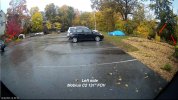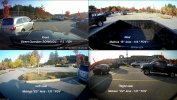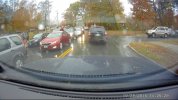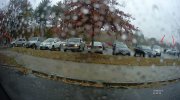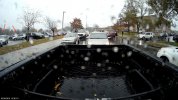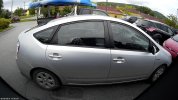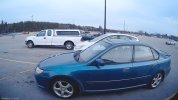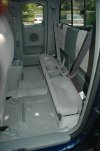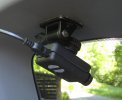The reason you manage 360 degree coverage is because:
1. The cams you have are among the widest view available and are not typical of most mainstream cams which have noticeably narrower field of view.
2. Your cams are all in close proximity of each other and relatively evenly spaced - perhaps 3ft apart.
In a passenger car the front and rear cams will be several feet apart and with side airbags and door opening to consider the side cams will need to be mounted in an A-pillar window (not present in all cars) or a C-pillar window (not present in all cars). That positions the side cam unequally between the front and rear cams which creates blind spots.
In the UK, pickups are not common. Large cars and vans are very common.
Below is a sketch of how different vehicle passenger compartment layouts can affect cam positions and create blind spots:
-

I really don't quite know what to make of or how to quite decipher the graphics you've posted but they appear to based on speculation, assumptions, and pet personal theories of how cameras in a vehicle would actually cover what is happening around one's car.
I hardly know where to begin.
So, speaking of "assumption", let's start with your statement: "
"The cams you have are among the widest view available and are not typical of most mainstream cams which have noticeably narrower field of view."
Where exactly did you come up with such a notion? That's simply not true. You might have thought to ask me before making such a remark.
My cameras are hardly among "
among the widest view available". In fact, they are rather narrow in the scheme of things in the world of currently available dash cams.
Currently my array is:
Front -
SG9665GC -
112 degrees FOV
Left facing -
Mobius C2 -
131 degrees FOV
Right facing -
Mobius C2 -
131 degrees FOV
Rear facing -
Mobius B lens -
116 degrees FOV
Then you go on to make a definitive assumption regarding the positioning of my cameras.
"Your cams are all in close proximity of each other and relatively evenly spaced - perhaps 3 ft apart."
Based on what evidence?
I drive an extended cab pick-up truck and therefore the cameras are
much farther apart than what you apparently assume. A typical two seater pick-up might be as you assume but today's double cab or extended pick-ups have interior space closer to that of a small sedan and my cameras are mounted at the top of the rear windows about where I would anticipate placing them in a car or SUV. (I actually have rear windows

)
You apparently
"assume" blind spots that do not actually exist outside of your diagrams and make definitive statements about just how large such blind spots might be again without offering any sort of evidence.
For some reason you postulate and attempt to demonstrate in your speculative graphics that the camera coverages will not be able to overlap, but they in fact can, and do.
You also use vague statements such as,
"it is possible". Well, I suppose any thing is possible but I prefer real world testing, experience and examples, whereas you appear to prefer theorizing and speculating.
While I would concede that a longer car may be different than a pick-up truck, that is indeed where those wider FOV lenses you speak of would come into play. There is no reason why four cameras cannot offer adequate all-around coverage of a vehicle as long as the cameras are mountable and properly placed. I believe the "blind spot" issue to be essentially a red herring for all practical purposes.
So, here are some further
"real world" examples of my four cameras listed above providing full 360 degree coverage around my vehicle with a significant amount of overlap beyond 360º and
virtually no blind spots, even very close .
I feel well protected here for full surrounding evidentiary capture should something unfortunate occur.

